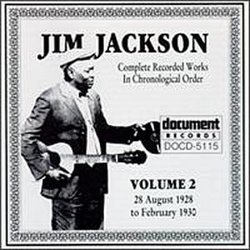Crucial African American music
Tony Thomas | SUNNY ISLES BEACH, FL USA | 02/20/2009
(5 out of 5 stars)
"The idea of pre-blues which most music scholars reject implies there is some sort of logical progression toward Blues or that other genre of music were eliminated by the emergence of Blues, but that is not true, especially since no African Americans folk or folk-pop musicians like Jackson were recorded until decades After the Blues had become an important genre of African American music.
Most recorded Blues artists had a much broader repertoire, but the recording companies usually demanded Blues and only Blues and what they thought were Blues. Much of this music is what can be called pop or country ragtime, Black country music merged with urban oriented pop music influenced by Ragtime. This music was a big part of what Black blues musicians played into the 1930s because the dances that were done to this music remained popular until Swing music replaced them. To survive, the central goal of a Blues singer and player was to be seen as a good dance player.
Jackson's "Going to Kansas City" was one of the first Downhome Blues hits by a Southern artist. On this CD he tries to play several remakes of the tune. Jackson probably had more latitude recording because he was a hit performer who sold records to Black folk across the country unlike most Blues musicians that current post-folk white Blues fans think were important like Charlie Patton and Robert Johnson whose records were only marketed in their local areas. This is probably why he was allowed to record a broad array of tunes.
The rest of the album presents a variety of songs that Jackson and other performers on medicine shows developed probably in the years between 1910 and 1920. If you are familiar with the repertoire of performers like Pink Anderson and Furry Lewis or of musicians who have mined their work for their repertoire like Doc Watson, you will find many familiar songs.
Almost all of these songs are copyrighted by Jackson as Jackson recorded for Ralph Peer of Victor who would only allow his artists to record songs he could copyright and publish as Victor paid him nothing but the publishing rights for his A & R work. However, many r of them were actually written, copyrighted, and published decades before by African American song writers for Black minstrelsy, stage shows, and even Broadway!
This was the staple of what Jackson performed in medicine shows where Jackson frequently worked in a string band that included himself on guitar, Furry Lewis Singing, and Gus Cannon on banjo. Unreleased recordings of songs on this and his other CD by Gus Cannon that I have heard show a great similarity between Cannon's style and Jacksons which is not surprising given that they played together and before Jackon's recording success got him bookings in Black vaudville.
Jackson's guitar is quite similar to that of Texas Ragtime Henry Thomas and other older Black guitarists. It probably dates to style popular before the turn of the 20th Century when guitars were rare and steel stringed guitars were rarer. It is a style that allowed a guitarist to play the string band repertoire that banjos and especially fiddles had use for Black dances since Africans came ashore, but also could swing the beat for the new dance crazes that spread with this music out of the rural Black south to the whole nationa nd beyond in the first thirty years of the 20th Century. You can see the fruition of this guitar style in the socalled Piedmont Blues style which developed in Georgia, the Carolinas, and Virginia where the old string band music held on the longest into the days when the Blues reigned.
Jackson's music is vital in that it reflects music that was popular before recordings were made of African American country singers. In this way the recording industry's recording pattern was a reverse of the history of Black country music. Blues singers whose background was singing the type of Blues that had been written by pop song writers since around 1908 recorded first. Rural Musicians whose music really was rooted in the pre-World War I world like Jackson, Gus Cannon, and Charlie Patton did not get recorded until the late 1920s.
Thank working medicine shows for preserving this approach to music in Jackson, as the medicine shows aimed at a small town and rural audience and championed what were already considered old fashioned country music. Cannon, Lewis, Jackson and other artists lived in Memphis where the shows that traveled all over the countryside of the South and the Midwest formed up. Off seasons they usually held day jobs, but played in the country in Tennessee, Misssissippi, and Arkansas on weekends where their older music was more popular than in Memphis where newer trends in Blues and Jazz prevailed.
Thus this is a music to country music Black folk were making when no white people felt like recording us."


 Track Listings (24) - Disc #1
Track Listings (24) - Disc #1